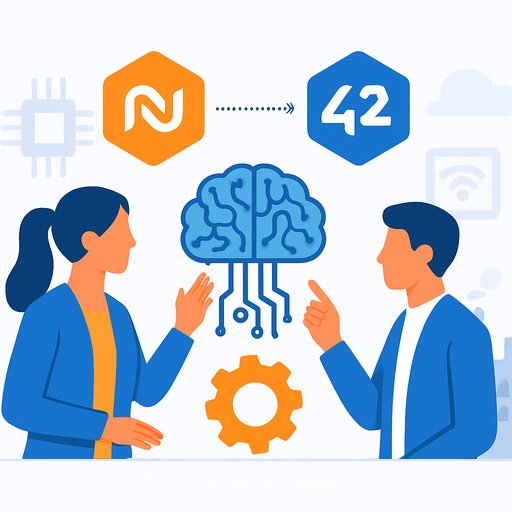InsurTech: from fear to proof of value
AI no longer signals doom; it signals the risk of being left behind. Insurance has held back for good reasons: regulation, trust, and legacy stacks. But the tipping point is here. Move with intent, or watch sharper competitors set the pace.
What the operators are seeing
Jake Wells, co-founder and COO at Meshed, is blunt: "AI is not going to bite you. Don't get left behind." Meshed connects a business's data to deliver real-time coverage from top insurers and trims commission by up to 30%.
Markerstudy's Andy Beal expects big disruption across internal processes and customer interactions. His caution: stop treating AI like alien tech. Core IT principles still apply. Architecture, governance, security, testing-none of that went away.
Confused.com's Richard Robinson frames today as peak hype before the dip. Value comes after the noise-if your data is fit for purpose. Data quality is the fuel. No fuel, no lift.
AI is a business problem first
Legal voices-like Addleshaw Goddard's Carly Gulliver and Weightmans' Michael Westcott-see the opportunity and the friction: due diligence, IP, cybersecurity, explainability, and compliance. The smart stance: use AI to support human judgment, not replace it. Expectations must be managed.
Outcome Path's Ade Webb warns against chasing only short-term efficiency. Consumers now use the same tools you do. If leadership doesn't plan for how trust and choice shift, you win the quarter and lose the next three years.
Why challengers are moving faster
Ex-Juniper leader Tom McMorrin has seen it: challengers ship or get acquired. Incumbent proofs-of-concept stall under risk aversion. Founders with higher risk appetite and domain expertise are building better products, faster.
Avoira's Ian Taylor sees the same blockage: data overwhelm. Teams burn cycles without a clear use case. His fix: run a proof of value tied to one business metric, prove it, then expand.
Sputnik Digital's Andy Nicol advises building AI as microservices that each do one small job well. Smaller scope = faster due diligence, clearer guardrails, less tech debt.
Trust, pricing, and explainability
In insurance, trust is oxygen. Robinson asks the key question: how do you improve efficiency while protecting customer trust? Fall behind customer expectations and catching up becomes expensive.
Wells pushes teams to interrogate data providers: if AI affects underwriting or pricing, what data sits underneath? Validate it to avoid bias and discrimination. McMorrin points out the non-negotiables: no discriminatory pricing, and explanations must be clear and regulated.
For practical guidance on data protection and AI, see the UK ICO's resources on AI and UK GDPR (ICO guidance).
Where to look for near-term wins
- Customer operations: speech analytics for QA, vulnerability detection, intent routing (Avoira's delivered this); agent assist to reduce handle time and complaints.
- Document-heavy workflows: intake, extraction, and validation for FNOL, bordereaux, sanctions checks, and claims evidence.
- Mid-office automation: quote/bind policy checks, referral triage, MI summaries, risk notes enrichment.
- Pricing support: scenario testing, backtesting, drift detection, and explanation tooling-without touching the core rating engine at first.
A product team playbook (use this next sprint)
- Pick one problem: tie it to a hard metric (e.g., -10% average handle time, -20% leakage, +15% same-day settlements).
- Do a data reality check: source of truth, permissions, PII handling, sampling bias, and latency. Fix basics before models.
- Prove value fast: ship a narrow microservice in 4-6 weeks. No big-bang platforms.
- Wrap guardrails: redaction, prompt logging, model versioning, human-in-the-loop, and audit trails.
- Measure like adults: A/B test, track productivity and error rates, capture customer impact, and run cost per task.
- Scale deliberately: if the metric moves, expand the scope; if not, kill it and move on.
Governance that won't slow you down
- Model register: who owns it, where it runs, what data it touches, and the business risk tier.
- Bias and explainability: test sensitive attributes, store rationales, and provide consumer-ready explanations for pricing.
- Security: data minimisation, encryption, isolation of prompts/outputs, and vendor risk reviews.
- People: train underwriters, claims handlers, and product managers in responsible use and escalation paths.
For broader risk frameworks, consider the NIST AI Risk Management Framework (NIST AI RMF).
Board buy-in without the drama
- Lead with a proof of value, not a platform. Show savings or revenue in weeks.
- Map to regulatory outcomes: fairness, explainability, consumer duty. Reduce perceived risk, approvals get faster.
- Use customer truth: real call snippets, real claim files, real quotes. Theory doesn't convert skeptics-evidence does.
Signals from across the market
- Meshed: real-time coverage and reduced commission-data-connected distribution.
- Markerstudy: deep data lakes, governance-first mindset.
- Confused.com: data quality before novelty; hype dip is coming, value after.
- Addleshaw Goddard and Weightmans: investor interest is high, but diligence and explainability are mandatory.
- Juniper → Fertifa: challengers scale fast or get bought.
- Avoira: speech analytics and vulnerable customer tools proving ROI.
- Sputnik Digital: microservice POCs to validate commercial value.
- Lockton: stay close to the customer; software isn't always the answer-sometimes the process is.
- Outcome Path: efficiency is table stakes; consumer trust is the long game.
- e-Zee Insurance Solutions: smaller MGAs will adopt carefully; data maturity will decide timing.
About the tech itself
Ade Webb calls AI a discordant technology-moving faster than social and regulatory norms. That gap creates tension: unregulated tools can outperform regulated ones. Your edge is disciplined adoption with clear value, guardrails, and honest comms to customers.
Sputnik's Andy Nicol offers perspective: the tech will look flawed right up until it doesn't. By then, the teams that ran small, focused experiments will be far ahead.
If you're building this quarter
- Pick two use cases: one for cost-out (ops), one for growth (conversion or retention).
- Stand up a microservice with HITL and measurable SLAs.
- Lock in governance, then automate testing and drift checks.
- Publish a one-page model card for internal stakeholders.
- Set a 90-day kill-or-scale decision gate.
InsurTech 50, 2025
This year's cohort signals where value is moving: distribution pipes wired to data, explainable pricing support, operations automation, and human-first design in claims and service. Expect consolidation. Expect some bold bets to miss. Expect the winners to own trust.
Level up your teams
If you need structured upskilling for product and data teams, explore curated AI training by job role here: AI courses by job. For tool scouting in financial services, this collection is a useful start: AI tools for finance.
Bottom line: AI won't replace your teams; it will amplify the ones who ship clear, governed, high-ROI use cases. Start small, move fast, show value, and protect trust. That's how you win the next cycle.
Your membership also unlocks:










